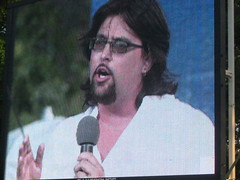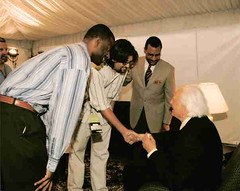The Economist weighs in on megachurches
From "Jesus, CEO: Churches as Businesses" (12/20/05):
... The corporate theme is not just a matter of appearances. Willow Creek has a mission statement (“to turn irreligious people into fully devoted followers of Jesus Christ”) and a management team, a seven-step strategy and a set of ten core values. The church employs two MBAs—one from Harvard and one from Stanford—and boasts a consulting arm. It has even been given the ultimate business accolade: it is the subject of a Harvard Business School case-study. ...This emphasis on customer-service is producing a predictable result: growth. John Vaughan, a consultant who specialises in mega-churches, argues that 2005 has been a landmark year. This was the first time an American church passed the 30,000-a-week attendance mark (it was Lakewood, which earlier this year moved into its new home in Houston's Compaq Center). It was also the first time that 1,000 churches counted as mega-churches (broadly, you qualify if 2,000 or more people attend). Willow Creek has seating for 7,200 (comfortable chairs, not wooden pews). The fastest-growing church in the country, Without Walls in Tampa, Florida, added 4,330 new members in the past year alone. ...
But this rapid growth brings problems in its wake too—problems that usually end up forcing churches to become yet more business-like and management-obsessed. The most obvious challenge is managing size. You cannot just muddle through if you have an annual income of $55m (like Lakewood in 2004) or employ 450 full- and part-time staff (like Willow Creek). Such establishments need to set up a management structure with finance departments and even human-resources departments. They also need to start thinking—like Mr Hybels—about the relationship between the religious leadership and the management team.
Another problem is subtler: how do you speak directly to individual parishioners when you have a church the size of a stadium? Some mega-churches have begun to see members drift away in search of more intimate organisations. And many mega-preachers worry that they are producing a flock who regard religion as nothing more than spectacle. So they have begun to adopt techniques that allow churches to be both big and small at once. ...
Yet three things can be said in the mega-churches' defence. The first is that they are simply responding to demand. Their target audience consists of baby-boomers who left the church in adolescence, who do not feel comfortable with overt displays of religiosity, who dread turning into their parents, and who apply the same consumerist mentality to spiritual life as they do to everything else. The mega-churches are using the tools of American society to spread religion where it would not otherwise exist.
The second line of defence is that they are simply adding to a menu of choices. There is no shortage of churches that offer more traditional fare—from Greek Orthodox to conservative Catholic. The third defence is more subtle: these churches are much less Disneyfied than they appear. They may be soft on the surface, but they are hard on the inside. The people at Lakewood believe that “the entire Bible is inspired by God, without error”. Cuddly old Rick Warren believes that “heaven and hell are real places” and that “Jesus is coming again”. You may start out in the figurative hell of a Disney theme-park, but you end up with the real thing.
The other common criticisms of the mega-churches—and the marriage of religion and business that they embody—are practical. One is that the mega-churches are a passing fad, doomed to be destroyed by a combination of elephantiasis and scandal. Another is that they are an idiosyncratic product of red-state America: amusing to look at, but irrelevant to the rest of the world. Again, neither argument is entirely convincing. ...













0 Comments:
Post a Comment
<< Home